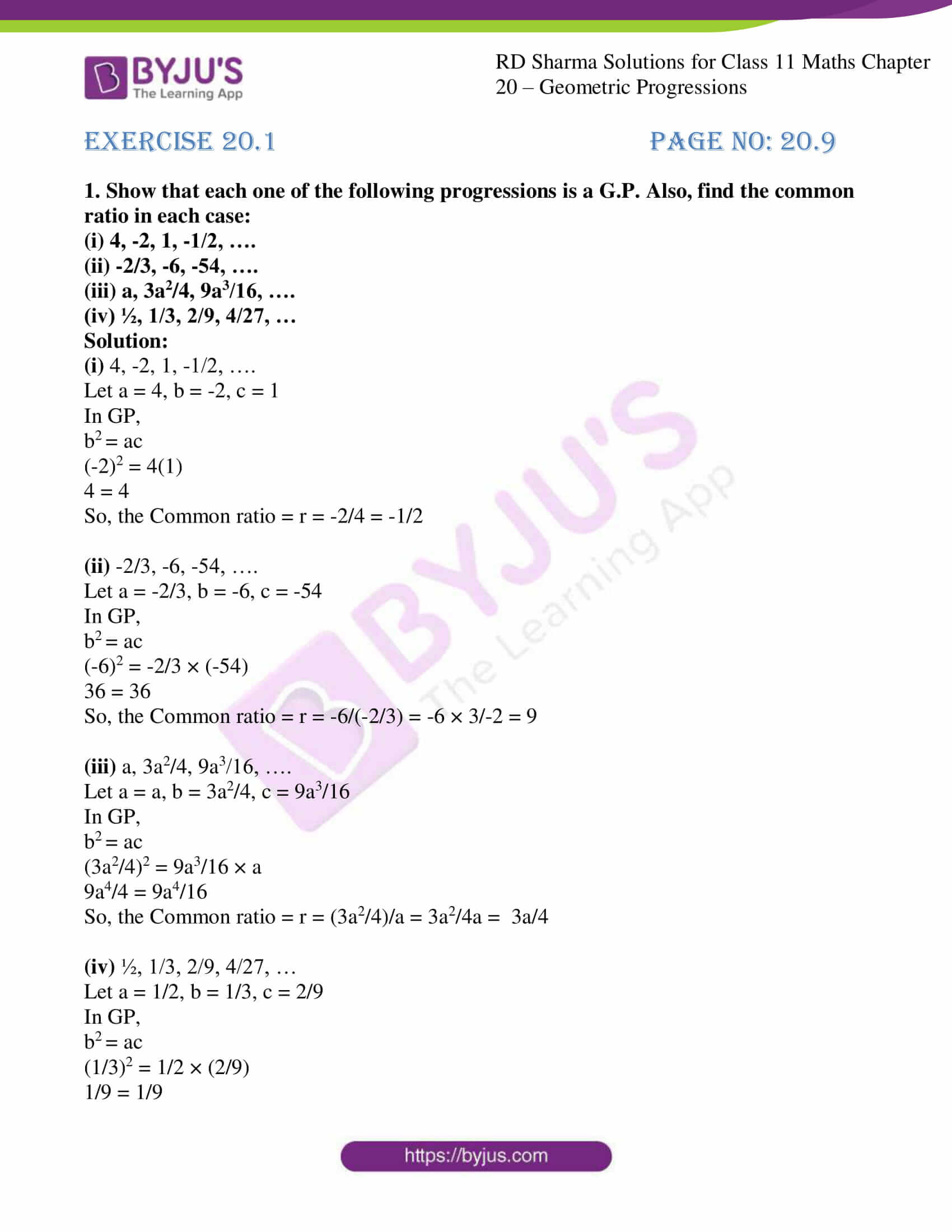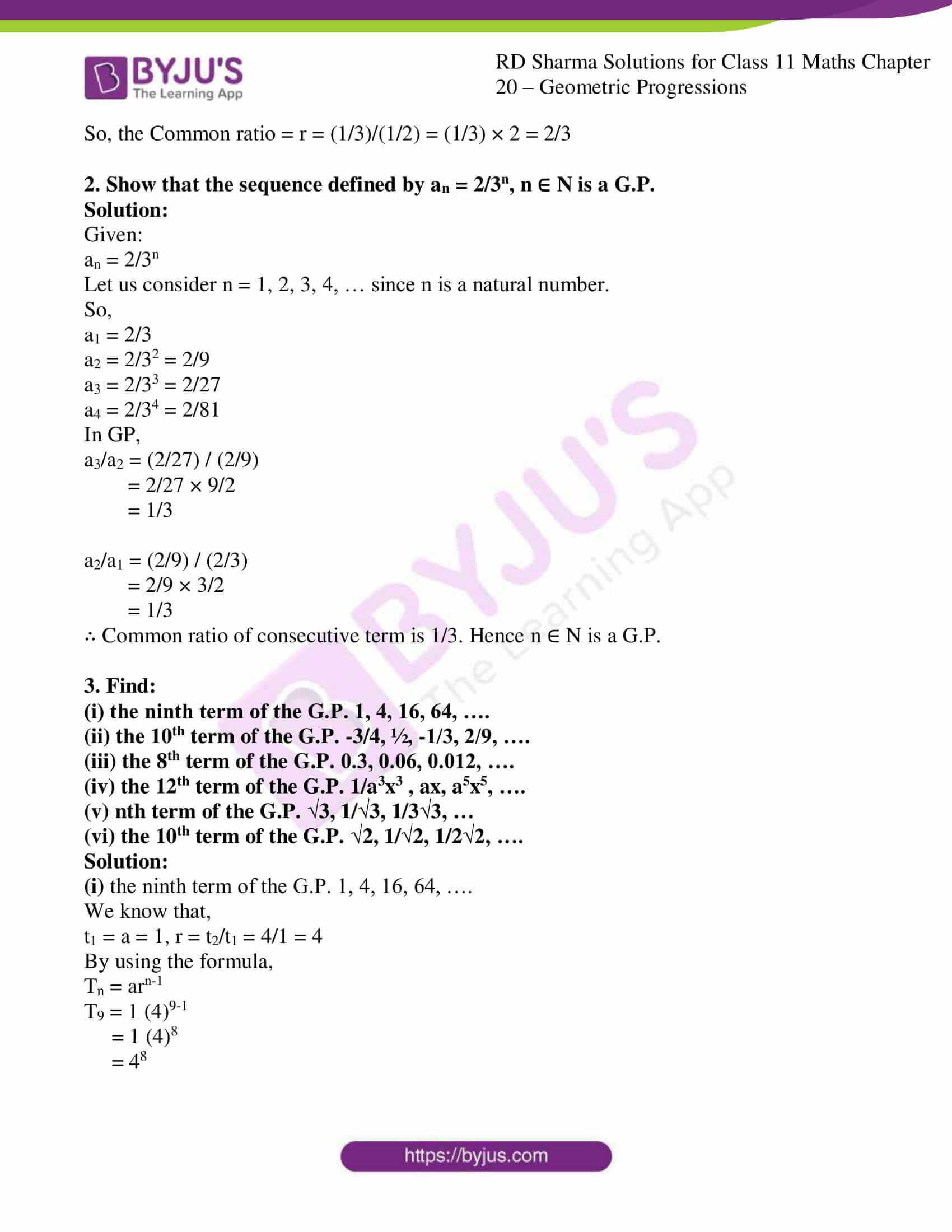This exercise mainly deals with problems based on geometric progression (G.P.) and the general term of a G.P. For students who face difficulty in understanding the concepts during class hours, the subject experts at BYJU’S have formulated the solutions in a simple language based on the students’ ability. Students can practice the examples and can solve exercise-wise problems with ease, which boosts their confidence level before appearing for the board exam. RD Sharma Class 11 Maths Solutions is readily available in PDF format for students to download easily and start practising offline.
RD Sharma Solutions for Class 11 Maths Exercise 20.1 Chapter 20 – Geometric Progression
Also, access other exercises of RD Sharma Solutions for Class 11 Maths Chapter 20 – Geometric Progression
Access answers to RD Sharma Solutions for Class 11 Maths Exercise 20.1 Chapter 20 – Geometric Progression
1. Show that each one of the following progressions is a G.P. Also, find the common ratio in each case:
(i) 4, -2, 1, -1/2, ….
(ii) -2/3, -6, -54, ….
(iii) a, 3a2/4, 9a3/16, ….
(iv) ½, 1/3, 2/9, 4/27, …
Solution:
(i) 4, -2, 1, -1/2, ….
Let a = 4, b = -2, c = 1
In GP,
b2 = ac
(-2)2 = 4(1)
4 = 4
So, the Common ratio = r = -2/4 = -1/2
(ii) -2/3, -6, -54, ….
Let a = -2/3, b = -6, c = -54
In GP,
b2 = ac
(-6)2 = -2/3 × (-54)
36 = 36
So, the Common ratio = r = -6/(-2/3) = -6 × 3/-2 = 9
(iii) a, 3a2/4, 9a3/16, ….
Let a = a, b = 3a2/4, c = 9a3/16
In GP,
b2 = ac
(3a2/4)2 = 9a3/16 × a
9a4/4 = 9a4/16
So, the Common ratio = r = (3a2/4)/a = 3a2/4a = 3a/4
(iv) ½, 1/3, 2/9, 4/27, …
Let a = 1/2, b = 1/3, c = 2/9
In GP,
b2 = ac
(1/3)2 = 1/2 × (2/9)
1/9 = 1/9
So, the Common ratio = r = (1/3)/(1/2) = (1/3) × 2 = 2/3
2. Show that the sequence defined by an = 2/3n, n ∈ N is a G.P.
Solution:
Given:
an = 2/3n
Let us consider n = 1, 2, 3, 4, … since n is a natural number.
So,
a1 = 2/3
a2 = 2/32 = 2/9
a3 = 2/33 = 2/27
a4 = 2/34 = 2/81
In GP,
a3/a2 = (2/27) / (2/9)
= 2/27 × 9/2
= 1/3
a2/a1 = (2/9) / (2/3)
= 2/9 × 3/2
= 1/3
∴ The common ratio of the consecutive terms is 1/3. Hence n ∈ N is a G.P.
3. Find:
(i) the ninth term of the G.P. 1, 4, 16, 64, ….
(ii) the 10th term of the G.P. -3/4, ½, -1/3, 2/9, ….
(iii) the 8th term of the G.P. 0.3, 0.06, 0.012, ….
(iv) the 12th term of the G.P. 1/a3x3 , ax, a5x5, ….
(v) nth term of the G.P. √3, 1/√3, 1/3√3, …
(vi) the 10th term of the G.P. √2, 1/√2, 1/2√2, ….
Solution:
(i) the ninth term of the G.P. 1, 4, 16, 64, ….
We know that,
t1 = a = 1, r = t2/t1 = 4/1 = 4
By using the formula,
Tn = arn-1
T9 = 1 (4)9-1
= 1 (4)8
= 48
(ii) the 10th term of the G.P. -3/4, ½, -1/3, 2/9, ….
We know that,
t1 = a = -3/4, r = t2/t1 = (1/2) / (-3/4) = ½ × -4/3 = -2/3
By using the formula,
Tn = arn-1
T10 = -3/4 (-2/3)10-1
= -3/4 (-2/3)9
= ½ (2/3)8
(iii) the 8th term of the G.P., 0.3, 0.06, 0.012, ….
We know that,
t1 = a = 0.3, r = t2/t1 = 0.06/0.3 = 0.2
By using the formula,
Tn = arn-1
T8 = 0.3 (0.2)8-1
= 0.3 (0.2)7
(iv) the 12th term of the G.P. 1/a3x3 , ax, a5x5, ….
We know that,
t1 = a = 1/a3x3, r = t2/t1 = ax/(1/a3x3) = ax (a3x3) = a4x4
By using the formula,
Tn = arn-1
T12 = 1/a3x3 (a4x4)12-1
= 1/a3x3 (a4x4)11
= (ax)41
(v) nth term of the G.P. √3, 1/√3, 1/3√3, …
We know that,
t1 = a = √3, r = t2/t1 = (1/√3)/√3 = 1/(√3×√3) = 1/3
By using the formula,
Tn = arn-1
Tn = √3 (1/3)n-1
(vi) the 10th term of the G.P. √2, 1/√2, 1/2√2, ….
We know that,
t1 = a = √2, r = t2/t1 = (1/√2)/√2 = 1/(√2×√2) = 1/2
By using the formula,
Tn = arn-1
T10 = √2 (1/2)10-1
= √2 (1/2)9
= 1/√2 (1/2)8
4. Find the 4th term from the end of the G.P. 2/27, 2/9, 2/3, …., 162.
Solution:
The nth term from the end is given by:
an = l (1/r)n-1 where l is the last term, r is the common ratio, n is the nth term
Given: the last term, l = 162
r = t2/t1 = (2/9) / (2/27)
= 2/9 × 27/2
= 3
n = 4
So, an = l (1/r)n-1
a4 = 162 (1/3)4-1
= 162 (1/3)3
= 162 × 1/27
= 6
∴ 4th term from last is 6.
5. Which term of the progression 0.004, 0.02, 0.1, …. is 12.5?
Solution:
By using the formula,
Tn = arn-1
Given:
a = 0.004
r = t2/t1 = (0.02/0.004)
= 5
Tn = 12.5
n = ?
So, Tn = arn-1
12.5 = (0.004) (5)n-1
12.5/0.004 = 5n-1
3000 = 5n-1
55 = 5n-1
5 = n-1
n = 5 + 1
= 6
∴ 6th term of the progression 0.004, 0.02, 0.1, …. is 12.5.
6. Which term of the G.P.:
(i) √2, 1/√2, 1/2√2, 1/4√2, … is 1/512√2 ?
(ii) 2, 2√2, 4, … is 128 ?
(iii) √3, 3, 3√3, … is 729 ?
(iv) 1/3, 1/9, 1/27… is 1/19683 ?
Solution:
(i) √2, 1/√2, 1/2√2, 1/4√2, … is 1/512√2 ?
By using the formula,
Tn = arn-1
a = √2
r = t2/t1 = (1/√2) / (√2)
= 1/2
Tn = 1/512√2
n = ?
Tn = arn-1
1/512√2 = (√2) (1/2)n-1
1/512√2×√2 = (1/2)n-1
1/512×2 = (1/2)n-1
1/1024 = (1/2)n-1
(1/2)10 = (1/2)n-1
10 = n – 1
n = 10 + 1
= 11
∴ 11th term of the G.P is 1/512√2
(ii) 2, 2√2, 4, … is 128 ?
By using the formula,
Tn = arn-1
a = 2
r = t2/t1 = (2√2/2)
= √2
Tn = 128
n = ?
Tn = arn-1
128 = 2 (√2)n-1
128/2 = (√2)n-1
64 = (√2)n-1
26 = (√2)n-1
12 = n – 1
n = 12 + 1
= 13
∴ 13th term of the G.P is 128
(iii) √3, 3, 3√3, … is 729 ?
By using the formula,
Tn = arn-1
a = √3
r = t2/t1 = (3/√3)
= √3
Tn = 729
n = ?
Tn = arn-1
729 = √3 (√3)n-1
729 = (√3)n
36 = (√3)n
(√3)12 = (√3)n
n = 12
∴ 12th term of the G.P is 729
(iv) 1/3, 1/9, 1/27… is 1/19683 ?
By using the formula,
Tn = arn-1
a = 1/3
r = t2/t1 = (1/9) / (1/3)
= 1/9 × 3/1
= 1/3
Tn = 1/19683
n = ?
Tn = arn-1
1/19683 = (1/3) (1/3)n-1
1/19683 = (1/3)n
(1/3)9 = (1/3)n
n = 9
∴ 9th term of the G.P is 1/19683
7. Which term of the progression 18, -12, 8, … is 512/729 ?
Solution:
By using the formula,
Tn = arn-1
a = 18
r = t2/t1 = (-12/18)
= -2/3
Tn = 512/729
n = ?
Tn = arn-1
512/729 = 18 (-2/3)n-1
29/(729 × 18) = (-2/3)n-1
29/36 × 1/2×32 = (-2/3)n-1
(2/3)8 = (-1)n-1 (2/3)n-1
8 = n – 1
n = 8 + 1
= 9
∴ 9th term of the Progression is 512/729
8. Find the 4th term from the end of the G.P. ½, 1/6, 1/18, 1/54, … , 1/4374
Solution:
The nth term from the end is given by:
an = l (1/r)n-1 where l is the last term, r is the common ratio, n is the nth term
Given: the last term, l = 1/4374
r = t2/t1 = (1/6) / (1/2)
= 1/6 × 2/1
= 1/3
n = 4
So, an = l (1/r)n-1
a4 = 1/4374 (1/(1/3))4-1
= 1/4374 (3/1)3
= 1/4374 × 33
= 1/4374 × 27
= 1/162
∴ 4th term from last is 1/162.







Comments